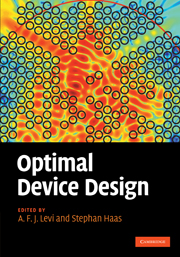Book contents
- Frontmatter
- Contents
- Preface
- Acknowledgements
- 1 Frontiers in device engineering
- 2 Atoms-up design
- 3 Electron devices and electron transport
- 4 Aperiodic dielectric design
- 5 Design at the classical–quantum boundary
- 6 Robust optimization in high dimensions
- 7 Mathematical framework for optimal design
- 8 Future directions
- Appendix A Global optimization algorithms
- About the authors
- Index
- References
7 - Mathematical framework for optimal design
Published online by Cambridge University Press: 04 May 2010
- Frontmatter
- Contents
- Preface
- Acknowledgements
- 1 Frontiers in device engineering
- 2 Atoms-up design
- 3 Electron devices and electron transport
- 4 Aperiodic dielectric design
- 5 Design at the classical–quantum boundary
- 6 Robust optimization in high dimensions
- 7 Mathematical framework for optimal design
- 8 Future directions
- Appendix A Global optimization algorithms
- About the authors
- Index
- References
Summary
Introduction
Fundamental to most optimal design is the replacement of the actual physical device by high fidelity mathematical models. Models are also used in place of sophisticated sensors and performance measuring instrumentation to avoid the costly and time-consuming process of building a large number of prototype devices fitted with sensors and monitored by the associated test equipment. These mathematical models also help to establish an unambiguous relationship between the design parameters and the performance of the device. This relationship is commonly referred to as the optimal design problem's performance index. Mathematical optimization theory can then be used to characterize local and global optimal designs. Moreover, by formulating the optimal design problem mathematically, we may employ sophisticated mathematical programming techniques to provide an efficient means to search for these local and global optimal designs. This is especially significant if the design space is high or even infinite dimensional. Thus, mathematics plays a central and essential role in solving optimal design problems.
In this chapter we describe how mathematical systems theory can be used to develop a framework for optimal design problems. In particular, we consider the device which is the basis for the optimal design and the environment it is interacting with as a system. The internal quantities that uniquely characterize the status of the system are referred to as the system states. For example, in the electromagnetic waveguide design problem described previously in Chapter 4, the structure of the waveguide, the dielectric Teflon cylinders, and the surrounding space form a system. The state variables of this system include the intensity and directions of the electric and magnetic fields.
- Type
- Chapter
- Information
- Optimal Device Design , pp. 189 - 245Publisher: Cambridge University PressPrint publication year: 2009



